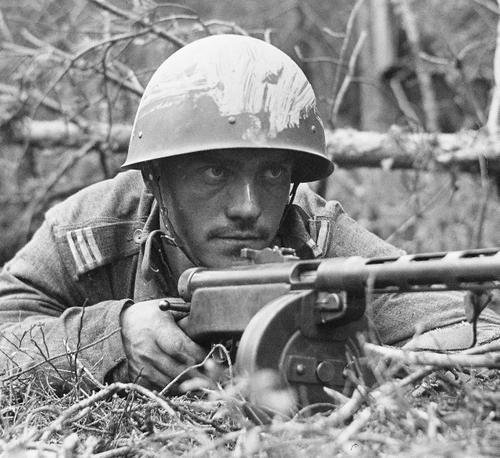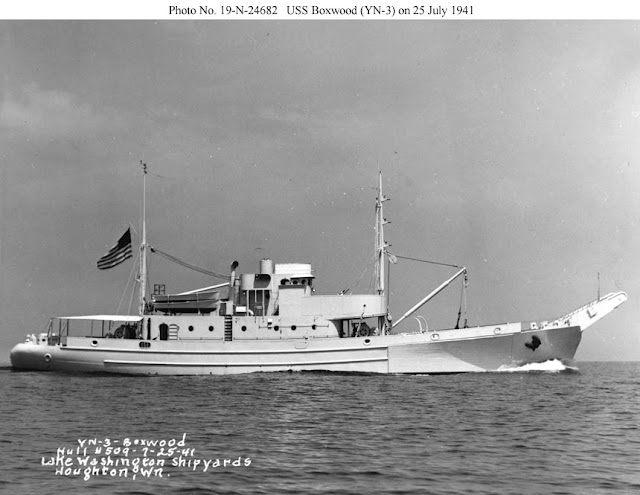Thursday 7 August 1941
 |
| Finnish Army anti-tank gun team at Ilmee (Rautjärvi), August 7, 1941 (SA-Kuva). |
The Finnish forces, though, are grinding forward against faltering Soviet opposition. However, some sectors are doing better than others, so Finnish Commander-in-Chief Marshal Mannerheim decides to focus on the most promising areas. To this end, he forms a new I Corps under Colonel Einar Mäkinen which includes Finnish 2nd, 7th, and 9th divisions. Mäkinen's first task is to eliminate the remaining Soviet troops north of Lake Ladoga.
In the Far North sector, the Finnish 2nd Division of II Corps reaches the northern shore of Lake Ladoga at Lahdenpohja. They thus join Finnish VI Corps, which reached the eastern shore of Lake Ladoga on 16 July. This isolates Soviet forces to the northwest, with Soviet 168th and parts of 115th divisions encircled in a large motti near Sortavala (Serdobol).
The Finns achieve a major victory further north, too, when Group J of 3rd Division of III Corps captures Kestenga in the evening. The Finns now are confident that they can cut the Murmansk railway because a spur line of the railroad from Kestenga leads directly to Loukhi on the mainline, providing a convenient pathway. An improved 42-mile road also leads from Kestenga to Loukhi. The Finnish advance to Loukhi also has flank protection provided by the Pya and Top lakes to the north and south. The Soviets, however, now realize the danger to the vital railway line and are hurriedly sending reinforcements to the area by train - a luxury the Finns do not have.
 |
| A Finnish soldier with a Browning Automatic Rifle (BAR) variant, August 7, 1941. |
In the Army Group Center sector, the German effort begins veering southward in accordance with Hitler's orders. General of Panzer Troops Geyr von Schweppenburg's XXIV Corps heads south toward Starodub in order to tie in with Army Group South. General Heinz Guderian's Panzer Group 2 also attacks south, toward Gomel.
In the Army Group South sector, the Germans continue fighting off attempts by the trapped Soviet soldiers of 6th and 12th Armies at Uman to break out. There are over 100,000 men trapped in the pocket, including numerous senior officers.
After dark, the Soviets sends bombers to raid Berlin in the first Soviet air raid on the capital of the war (the British have been bombing Berlin since 25 August 1940 and the French first bombed it on 7 June 1940). This is Operation B (for Berlin), and it is the brainchild of Lt. Gen. Semyon F. Zhavoronkov and approved by Soviet Admiral Nikolay G. Kuznetsov. Stalin has given the final approval necessary for the operation.
The fifteen twin-engined Ilyushin DB-3T torpedo bombers of the 1st Torpedo Bomber Regiment of the Baltic Fleet (yes, it is the Soviet Navy that makes the attack) fly from Kagul airfield on the island of Saaremaa off the Estonian coast. The planes travel over 600 miles (1000 km), and all return safely. Damage is light - the planes carry less than 1000 pounds of bombs each because of the distance, and some fall relatively harmlessly in the suburbs - but the attack is trumpeted by Soviet propaganda. The Germans are taken by surprise and first ascribe the raid to the RAF, but later learns the truth.
 |
| Soviet Ilyushin DB-3T. |
During the night, RAF Bomber Command attacks three German cities:
- Essen Krupps factory with 106 aircraft (54 Hampdens, 32 Wellingtons, 9 Halifaxes, 8 Stirlings, 3 Manchester bombers - 2 Hampdens and 1 Stirling lost)
- Hamm railway yards with 46 aircraft (45 Wellingtons and a Sterling, no losses)
- Dortmund with 20 Wellingtons and 20 Whitleys, no losses.
 |
| Colonel Evgeniy N. Preobrazhenskiy, commander of the Soviet 1st Torpedo Bomber Regiment, inspects one of his Ilyushin DB-3T bombers prior to the first Soviet raid against Berlin on August 7-8, 1941. |
Estonian submarines Kalev and Lembit lay mines off Bornholm.
Battle of the Atlantic: The Luftwaffe bombs and damages 8208-ton British tanker Gold Shell in the North Sea off Hartlepool. The Gold Shell makes it to Hell and then Middlesborough under tow for repair.
The Luftwaffe bombs Royal Navy minesweeper HMS MMS.39 with an aerial mine. MMS.39 sinks in the Thames Estuary.
Danish freighter Venus hits a mine and sinks in the North Sea off Borkum, Lower Saxony, Germany.
Royal Navy submarine Severn claims to attack and sink a submarine west of Gibraltar. However, there is no confirmation of this.
U-451, operating off Cape Teriberka in the Arctic attacks a Soviet patrol boat but misses.
Royal Navy destroyers HMS Active and Antelope arrive back in Seidisfjord, Iceland upon completion of Operation EF, the attack on Kirkenes and Petsamo. They both sail for England later in the day. Heavy cruiser Devonshire and aircraft carrier Victorious arrive back at Scapa Flow after Operation EF. Operation FB also ends when light cruisers Aurora and Nigeria arrive back at Scapa Flow with their destroyers.
US battleship USS Arkansas (BB-33) departs from Hampton Roads, Virginia on a neutrality patrol, accompanied by destroyers Mayrant and Rhind.
Royal Navy light cruiser HMS Uganda is launched.
Australian minesweepers HMAS Kalgoorlie and Castlemaine are launched.
U-582 (Kapitänleutnant Werner Schulte) is commissioned, U-524 and U-628 are laid down.
 |
| The Soviet bombing of Berlin from Saaremaa Island, 7 August 1941. |
Operation Guillotine, the British reinforcement of Cyprus, continues. Light cruiser Neptune, minelaying cruiser Abdiel, and destroyer Jackal depart from Port Said for Famagusta carrying troops. The Luftwaffe attacks Famagusta harbor and sinks 332-ton tug Amiral Lacaze, but it is later refloated and repaired.
The Vichy French, in accordance with the terms of the treaty ending the conflict in the Levant, send a convoy carrying 4777 troops from Haifa back to France. These troops have decided not to join the Free French.
Germany Military: Werner Mölders, 28, is appointed Inspector of Fighters (Inspekteur der Jagdflieger). He now will decide the ongoing tactical and operational doctrine of the Luftwaffe. While he no longer will fly officially on missions, he does have a personal Fieseler Fi 156 Storch transport for his personal use to visit forward airfields. He also, on occasion, flies "teaching missions" and the like that have a tendency to find the enemy.
 |
| Captain Bruno Mussolini. |
There was a Mussolini before Bruno’s death, and a Mussolini after it. Prior to August 7, 1941, despair was not part of his emotional range. The tragedy turned him into a different man whose lost stare, at times, provoked pity.Bruno is interred in the family crypt in the San Cassiano cemetery in the town of Predappio.
 |
| Colonel Evgeniy N. Preobrazhenskiy, who led the 1st Torpedo Bomber Regiment, talks with navigator Pyotr Khokhlov, who flew on Operation B’s first mission against Berlin on August 7-8, 1941. |
US Government: Aboard cruiser USS Augusta (CA-31) and accompanied by cruiser Tuscaloosa (CA-37), President Roosevelt arrives at Placentia Bay, Argentia, Newfoundland. He whiles away the remainder of the day fishing from Augusta's forecastle - which is somewhat ironic, considering that the cover story in the press is that he is fishing, but much further south. He awaits a pending visit from Winston Churchill, who is steaming west on battleship HMS Prince of Wales. This is the closest that President Roosevelt has come to arguably hostile forces, as the Vichy French islands (they have pledged allegiance to Vichy) of Saint Pierre and Miquelon are only about a hundred miles away. Nobody expects any trouble from them, though, and they are being closely watched. The Canadian Chiefs of Staff Committee already has approved a plan to invade the islands, but Roosevelt's proximity to them appears to focus Allied interest in the tiny French territories.
The US Senate votes to extend the draft period from 12 to 30 months.
 |
| A Piaggio P.108 Bombardiere similar to the one in which Bruno Mussolini perished. |
Holocaust: The Romanians shoot 551 Jews in the Kishinev Ghetto.
British Homefront: The Home Guard has planted many minefields to defend against an invasion. However, the government is learning that they are as effective against civilian trespassers on the clearly marked areas as they would be against invading troops. Five people are killed by mines this week, three in Northumberland and two at Torquay.
American Homefront: Columbia Pictures releases "Here Comes Mr. Jordan," directed by Alexander Hall and starring Robert Montgomery, Evelyn Keyes, and Claude Rains. Opening at the Radio City Music Hall in New York City, reviews are excellent for the romantic comedy-fantasy film about a boxer who is mistakenly sent to Heaven before his time. "Here Comes Mr. Jordan" becomes influential and results in a quasi-sequel, "Down to Earth" (1947), and a 1978 remake starring Warren Beatty called "Heaven Can Wait." It also begins a trend of films featuring guardian angels or spiritual beings with worldly influences that ultimately leads indirectly to classics such as "It's a Wonderful Life" (1946), "The Bishop's Wife" (1947), "Angels in the Outfield" (1951), and "Damn Yankees" (1958). The film is nominated for seven Academy Awards and wins two for writing.
Television station WNBT Channel 4 in New York City (the future NBC affiliate) broadcasts the first audience-participation show, revolving around charades. WNBT is a combination of the National Broadcasting Company (RCA's broadcasting subsidiary) and the new technology of television. It is the only NYC station with a commercial license because it has committed to 15 hours of telecasts per week. As the most advanced television station in the country, it can draw on RCA's extensive talent roster and already is airing commercials.
August 1941
August 2, 1941: Uman Encirclement Closes
August 3, 1941: Bishop von Galen Denounces Euthanasia
August 4, 1941: Hitler at the Front
August 5, 1941: Soviets Surrender at Smolensk
August 6, 1941: U-Boats in the Arctic
August 7, 1941: Soviets Bomb Berlin
August 8, 1941: Uman Pocket Captured
August 9, 1941: Atlantic Conference at Placentia Bay
August 10, 1941: Soviet Bombers Mauled Over Berlin
August 11, 1941: Rita Hayworth in Life
August 12, 1941: Atlantic Charter Announced
August 13, 1941: The Soybean Car
August 14, 1941: The Anders Army Formed
August 15, 1941: Himmler at Minsk
August 16, 1941: Stalin's Order No. 270
August 17, 1941: Germans in Novgorod
August 18, 1941: Lili Marleen
August 19, 1941: Convoy OG-71 Destruction
August 20, 1941: Siege of Leningrad Begins
August 21, 1941: Stalin Enraged
August 22, 1941: Germans Take Cherkassy
August 23, 1941: Go to Kiev
August 24, 1941: Finns Surround Viipuri
August 25, 1941: Iran Invaded
August 26, 1941: The Bridge Over the Desna
August 27, 1941: Soviets Evacuate Tallinn
August 28, 1941: Evacuating Soviets Savaged
August 29, 1941: Finns take Viipuri
August 30, 1941: Operation Acid
August 31, 1941: Mannerheim Says No
2020














